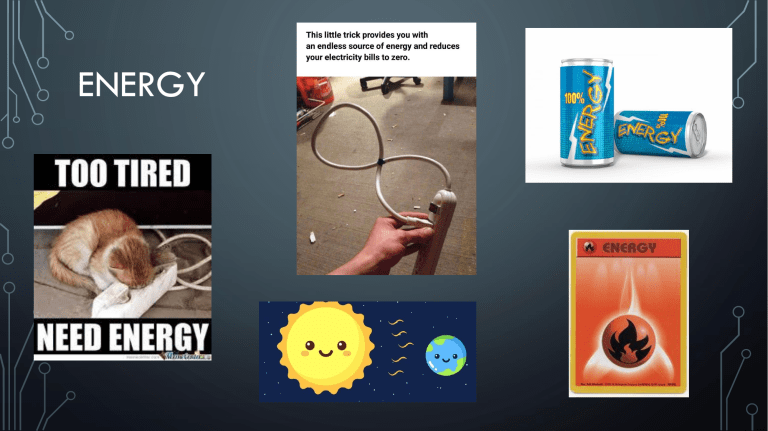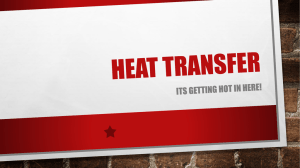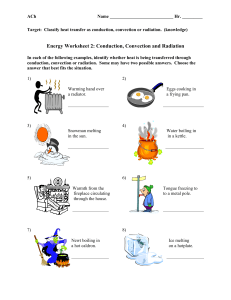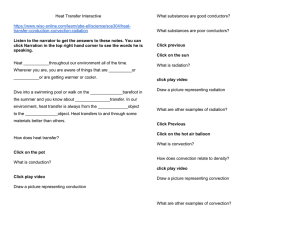
ENERGY LEARNING INTENTION • We will understand how energy transfers through different mediums. SUCCESS CRITERIA • I can recall what energy is • I can explain what heat energy is and why some objects possess more heat energy than others WHAT IS ENERGY?? Answer the following question individually in your notes? What is energy? What types of energy are there? WHAT IS ENERGY?? Put your answers to the questions into a brainstorm with the rest of your table. What is energy? What types of energy are there? WHAT IS ENERGY?? Pass your butchers paper to another table. Add onto the brainstorm that they have made. What is energy? What types of energy are there? WHAT IS ENERGY?? Energy is the ability to change something else. We could change how something is moving, the temperature of something or even the shape of an object. That is energy allows things to do work. EDUCATION PERFECT Complete the Education Perfect task on Energy ENERGY TRANSFORMATION Energy is able to change from one form into another. This is called an energy transformation or energy chain. The device or organism that changes the energy is called an energy changer. ENERGY TRANSFORMATION Answer the following questions in a small group on your table by adding to your original brainstorm. What examples of energy transformations can you recall? What energy changer causes it? HEAT ENERGY Heat energy is the amount of movement energy that particles in an object possess. The more the particles in an object vibrate, the hotter the object is. HEAT ENERGY Hot objects have more particle movement and therefore more heat energy. Cold objects have less particle movement and therefore less heat energy. CONDUCTION CONDUCTION Conduction is the transfer of heat energy in solids. Particles in solids are close together and they vibrate more when they heat up. They pass on this energy to the particles nearby by colliding with them. Metals are the best conductors of heat energy. They also have electrons that are free to move further and faster to carry heat energy quicker. THINKING POINTS: CONDUCTION ● Most saucepans are made from metal with plastic handles. THINKING POINTS: CONDUCTION ● Serving dishes are usually made from glass or china (why?). THINKING POINTS: CONDUCTION ● Fake jewellery? Touching a diamond to your lips will allow jewellers to tell if it is glass or diamond. A real diamond feels cold because it is a good conductor of heat. THINKING POINTS: CONDUCTION ● Baked alaska dessert - cooked meringue on the outside and frozen ice cream inside. THINKING POINTS: CONDUCTION ● Why does water at 0C feel colder than ice at 0C? CONVECTION CONVECTION Convection is the transfer of heat energy in liquids and gases. Particles near the heat source gain energy and move further apart. The liquid or gas becomes less dense and rises. A convection current forms. New particles are brought close to the heat source. THINKING POINTS: CONVECTION ● Double-glazed windows have air or a partial vacuum between the panes of glass. Air is a poor conductor; a partial vacuum is even poorer (can you explain why?). The gap between the panes is narrow, so there is not enough room for a convection current to be set up. THINKING POINTS: CONVECTION ● Computers and other devices use forced convection to cool them. A fan blows cool air across hot components. The air heats up and is removed by convection currents. RADIATION RADIATION When there are no particles to carry heat energy, heat is transferred by waves of radiation. Matte black is the best absorber and emitter of radiation. Shiny silver is the worst absorber and emitter of radiation. THINKING POINTS: RADIATION ● The cooling fins on car radiators and on the backs of fridges should be black. THINKING POINTS: RADIATION ● Climbers or walkers suffering from hypothermia are wrapped in shiny silver ‘space blankets’. THINKING POINTS: RADIATION ● Buildings and clothes in very hot countries are usually white or lightcoloured. THINKING POINTS: RADIATION ● Fuel storage tanks are usually painted white or silver. THINKING POINTS: RADIATION ● Polar bears have white fur and black skin. LEARNING INTENTION • We will understand how energy transfers through different mediums. SUCCESS CRITERIA • I can explain why objects heat up at different speeds • I can explain why different parts of Australia will have a different temperature and explain the general trend HEATING AND COOLING – SOLIDS VS LIQUIDS Temperature of Sand and Water in Sunlight Sand temperature Water Temperature Линейная (Sand temperature) Линейная (Water Temperature) 23,5 23 Temperature (°C) 22,5 22 21,5 21 20,5 20 0 50 100 150 200 250 Time (seconds) 300 350 400 ‘Explain’ Year 9 ECOSYSTEMS What is needed to ‘explain’? cause effect linking word/phrase (provide why and how) DON’T repeat the question in the answer. What are some examples of linking words? Examples of Linking Words hence induce generated is designed to therefore thus as a consequence consequently in order to causes encourages promotes because to due to Example: highlight the cause, effect and linking words Q: Explain why plants require access to light. Cause Linking Words Effect Example: highlight the cause, effect and linking words Q: Explain why plants require access to light. A: Plants undergo photosynthesis in order to produce their own food in the form of glucose. Chlorophyll in plants convert light energy from the sun into chemical energy in order to allow photosynthesis to occur. If light is not present the plant can not produce glucose and consequently will not survive. Example: highlight the cause, effect and linking words Q: Explain why plants require access to light. A: Plants undergo photosynthesis in order to produce their own food in the form of glucose. Chlorophyll in plants convert light energy from the sun into chemical energy in order to allow photosynthesis to occur. If light is not present the plant can not produce glucose and consequently will not survive. HEATING AND COOLING – SOLIDS VS LIQUIDS Individually answer the following explain question: Explain what you observed in your experiment. TRY THESE ‘EXPLAIN’ QUESTIONS Individually complete the following explain questions: - - Explain how heat travels in ecosystems (Hint: refer to conduction, convection and radiation) Explain the use of a data logger to measure temperature in an ecosystem rather than a thermometer HEAT MAP OF AUSTRALIA Individually note down any observations you have about the temperature map of Australia. Share your observations with the people around you and add any new observations to your sheet. HEAT MAP OF AUSTRALIA Individually note down anything you wonder and would like to find out about the temperature map of Australia. Share your wonders with the people around you and try and find answers to the questions. HEAT MAP OF AUSTRALIA Individually colour in the other map of Australia, with what you predict the temperature will be like at 2am on the 15th January 2013. Explain the science behind your prediction.



